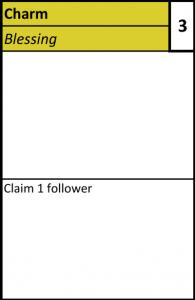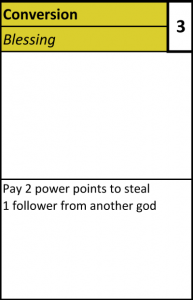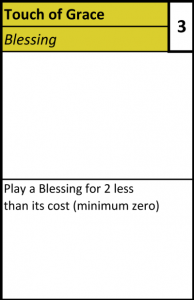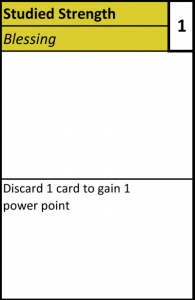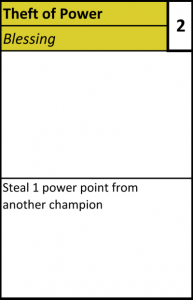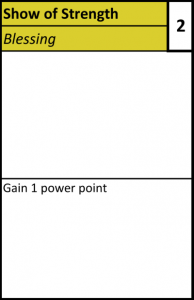Previous posts: Part 1 / Part 2 / Part 3
As National Game Design Month (NaGaDeMon) rolls on, I’m working on a new board game, Gods & Champions. Each player gets to be a God, acting through a Champion to claim Followers. The God with the most Followers at the end of three Ages wins the game.
In the past couple of weeks, I’ve spent more of my game development time on the expansion to Chaos & Alchemy and less on Gods & Champions, but I haven’t totally abandoned my game development. As a matter of fact, I had a fantastically helpful playtesting session this past Sunday with some new friends.
Current state of the rules
Here’s the way things work right now:
- Each player randomly gets a secret God card, which they can either keep secret throughout the game and reveal at the end for bonus points, or reveal at any point to activate the God’s ability, giving up the bonus points. (I haven’t actually played with the God cards at all so far; I want to make sure the Champions work first).
- Each player gets a face-up Champion card, most likely through some type of opening hand size bidding mechanism (still under development – for now, initial Champion assignment is random).
- In the first Age of the game, five Follower tokens per player (so, 15 tokens in a three-player game) are put on the board. (I’m currently using white poker chips for Followers.) The Age will end when all of the Followers are gone. (I’ve also experimented with rules that give everyone three turns per Age and rules that let you keep claiming Followers after the pool is empty until everyone has had an equal number of turns, but I find it more interesting to deal with the fixed pool of Followers).
- After each Age, the player who claimed the most Followers in that Age gets some bonus Followers. Then there is a re-draft of Champions, starting with the player in last place.
- The Second Age cards are shuffled into the deck at the beginning of the second Age, and the Third Age cards are introduced at the start of the third Age. (I’m also experimenting with entirely replacing the prior Age’s cards rather than shuffling them together.)
- The second Age has 10 Followers per player available, and the third Age has 15 per player (this might end up at 20 per player). Each Age awards bonus Followers to the winner of the Age, and is followed by a re-draft of Champions.
- The Champions are worth points at the end of the game (rules still under development; it will probably be based on the total value of Blessings on the Champion).
- There are some Quest cards available that your God can claim if certain circumstances are met. (I haven’t playtested these at all yet; they’ll probably be an advanced rules module for later.)
These rules are still a bit in flux, but I’m getting close here. Of course, the big question is, what do you do on your turn?
Turn order
- Receive 2 Power (currently represented by red poker chips) from the bank. In the second Age, this increases to 3 Power. In the third Age, it’s 4 Power.
- Use each ability of your Champion once (skipping any abilities you don’t wish to use), in any order you like.
- Claim 1 card from the board. You can either take the card in the free slot, pay 1 Power for the card in the 1-power-slot, pay 2 Power for the card in the 2-power-slot slot, or pay 1 Power to draw a random card from the deck. The cards then get cheaper (shift them down one space, discarding the free-slot card if a card was drawn from the deck) and a new card shows up in the 2-power-slot.
- Play any number of cards from your hand, paying the Power cost for each card. Most of these are Blessings that give your Champion new abilities for future turns, but there are also Miracles that have one-shot effects on the board right away.
In addition, there are two things that you can do at any time on your turn, as often as you wish:
- Discard two cards to gain 1 Power
- Pay 2 Power to claim 1 Follower
When it comes to Champions, they each have three slots for Blessings. If you want to replace an old Blessing with a new one, you can essentially “sell” the old Blessing for half its original cost (probably rounded down, but I’m experimenting with rounding up, too) and pay the difference for the new one. You can’t downgrade a Blessing to a less expensive card in order to downgrade your Champion near the end of an Age (since someone else might get that Champion for the next Age).
Open issues
The game is actually fun right now, largely thanks to the theme (it’s fun to be a God – who knew?). The mechanics are okay, but there are ares for improvement:
- Some of the cards, especially the later Age cards, are out of whack in cost compared to their power level (too cheap or too expensive). This is pretty easy to tweak.
- A lot of my cards don’t have names yet. Not that hard to fix, but the flavor is going to be really important in this game, so I have to do a good job here.
- The whole business of re-drafting Champions each Age is what I originally wanted to explore but, as I feared, it might not be that much fun in the end. If I ditch it, I’ll need a new catch-up mechanic.
- Card selection is currently not that important. If you have five cards in your hand, you don’t much care what most of them do, since you’re only going to be playing one or two each turn. The rest will be discarded for Power. This is a problem. It might be solvable by letting you do other things with cards in hand (perhaps you can discard them for more Power if they’re more expensive). Alternatively, I might make it so that you just don’t get all that many cards, though I like having the exchanges between the three currencies (cards, Power, Followers).
Next steps
From here, I’m hoping to find time for some more rules tweaking this week, followed by more playtesting later in the week. I don’t know that the game will be “finished” by the end of November, but I think I can at least put something playable up here on the blog by December 1. I’ll continue working on it from there, but I think I should be able to declare at least a partial victory on NaGaDeMon 2012 by the end of the week.
-Michael the OnlineDM


